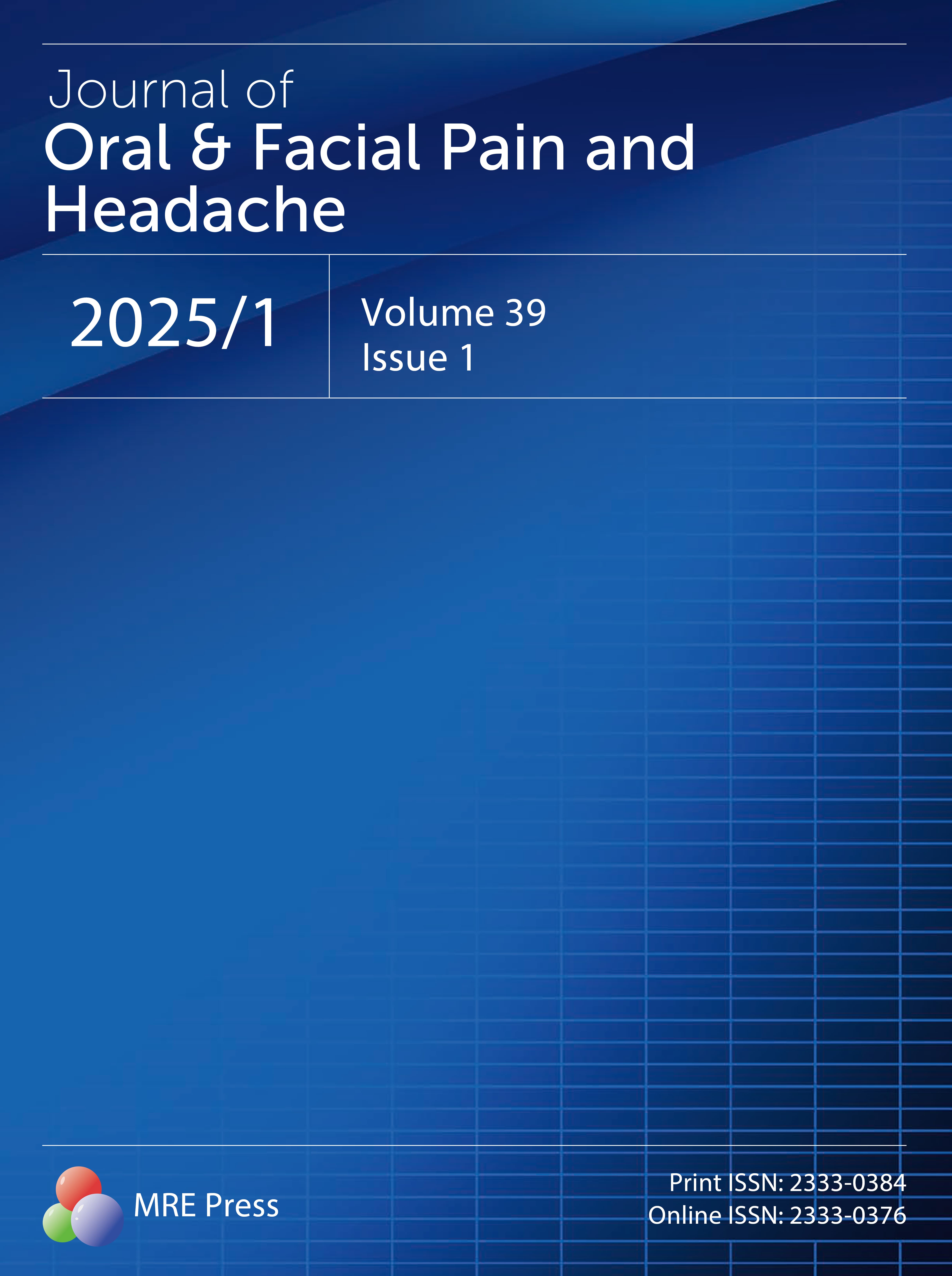Title
Author
DOI
Article Type
Special Issue
Volume
Issue
Article Menu
Export Article
More by Authors Links
Article Data
- Views 1229
- Dowloads 118
Journal of Oral & Facial Pain and Headache (OFPH) is published by MRE Press from Volume 38 lssue 1 (2024). Previous articles were published by another publisher on a subscription basis, and they are hosted by MRE Press on www.jofph.com as a courtesy and upon agreement with Journal of Oral & Facial Pain and Headache.
Original Research
Open AccessSphenopalatine Ganglion Block with Botulinum Neurotoxin for Treating Trigeminal Neuralgia Using CAD/CAM–Derived Injection Guide
Sphenopalatine Ganglion Block with Botulinum Neurotoxin for Treating Trigeminal Neuralgia Using CAD/CAM–Derived Injection Guide
1Department of Oral and Maxillofacial Surgery, National Hospital Organization, Kyoto Medical Center, Kyoto, Japan
DOI: 10.11607/ofph.2510 Vol.34,Issue 2,June 2020 pp.135-140
Submitted: 14 April 2019 Accepted: 27 June 2019
Published: 30 June 2020
*Corresponding Author(s): Kazuya Yoshida E-mail: yoshida.kazuya.ut@mail.hosp.go.jp
Abstract
Aims: To examine the effectiveness and safety of using a CAD/CAM–derived injection guide for botulinum neurotoxin block of the sphenopalatine ganglion for trigeminal neuralgia treatment. Methods: Ten patients with second-division trigeminal neuralgia who did not respond to submucosal administration of botulinum neurotoxin were enrolled in this study. The target point around the sphenopalatine fossa was determined after fusion of computed tomography data with a scan of a maxillary model using a software program for dental implant surgery. A CAD/CAM–derived injection guide was fabricated. The guide was affixed to the patient’s maxilla, and a needle was inserted to an exactly analyzed depth. Subsequently, 50 units of botulinum neurotoxin were injected. Pain intensity evaluated using a visual analog scale and pain frequency were measured. Results: By using the guides, sphenopalatine ganglion block with botulinum toxin was performed 18 times without any complications. The visual analog scale score (8.1 ± 1.0) and pain frequency (19.4 ± 8.8 times/day) decreased (to 1.9 ± 1.4 and 4.9 ± 5.4 times/day, respectively) significantly (P < .001). After 4 weeks, the mean subjective improvement achieved was 77.5% ± 13.8%, and all patients responded to treatment. Conclusion: Even without prior experience of sphenopalatine ganglion block, the CAD/CAM–derived guide enabled the accurate and safe administration of botulinum neurotoxin to the sphenopalatine ganglion for the treatment of trigeminal neuralgia.
Keywords
botulinum neurotoxin therapy; computer-aided design/computer-assisted manufacturing; sphenopalatine ganglion; surgical template; trigeminal neuralgia
Cite and Share
Kazuya Yoshida. Sphenopalatine Ganglion Block with Botulinum Neurotoxin for Treating Trigeminal Neuralgia Using CAD/CAM–Derived Injection Guide. Journal of Oral & Facial Pain and Headache. 2020. 34(2);135-140.
References
1. The International Classification of Headache Disorders, 3rd edition. Cephalalgia 2018;38:1–211.
2. Aoki KR. Review of a proposed mechanism for the antinociceptive action of botulinum toxin type A. Neurotoxicology 2005;26:785–793.
3. Yoshida K, Iizuka T. Botulinum toxin treatment for upper airway collapse resulting from temporomandibular joint dislocation due to jawopening dystonia. Cranio 2006;24:217–222.
4. Yoshida K. Computeraided design/computerassisted manufacturederived needle guide for injection of botulinum toxin into the lateral pterygoid muscle in patients with oromandibular dystonia. J Oral Facial Pain Headache 2018;32:e13–e21.
5. Yoshida K. How do I inject botulinum toxin into the lateral and medial pterygoid muscles? Mov Disord Clin Pract 2016;4:285.
6. Yoshida K. Botulinum neurotoxin therapy for lingual dystonia using an individualized injection method based on clinical features. Toxins (Basel) 2019;11. pii: e51.
7. Borodic GE, Acquadro MA. The use of botulinum toxin for the treatment of chronic facial pain. J Pain 2002;3:21–27.
8. Piovesan EJ, Teive HG, Kowacs PA, Della Coletta MV, Werneck LC, Silberstein SD. An open study of botulinumA toxin treatment of trigeminal neuralgia. Neurology 2005;65:1306–1308.
9. Zúñiga C, Díaz S, Piedimonte F, Micheli F. Beneficial effects of botulinum toxin type A in trigeminal neuralgia. Arq Neuropsiquiatr 2008;66:500–503.
10. Bohluli B, Motamedi MH, Bagheri SC, et al. Use of botulinum toxin A for drugrefractory trigeminal neuralgia: Preliminary report. Oral Surg Oral Med Oral Pathol Oral Radiol Endod 2011; 111:47–50.
11. Wu CJ, Lian YJ, Zheng YK, et al. Botulinum toxin type A for the treatment of trigeminal neuralgia: Results from a randomized, double-blind, placebo -controlled trial. Cephalalgia 2012; 32:443–450.
12. Zúñiga C, Piedimonte F, Díaz S, Micheli F. Acute treatment of trigeminal neuralgia with onabotulinum toxin A. Clin Neuropharmacol 2013;36:146–150.
13. Shehata HS, El-Tamawy MS, Shalaby NM, Ramzy G. Botulinum toxin-type A: Could it be an effective treatment option in intractable trigeminal neuralgia? J Headache Pain 2013;14:92.
14. Zhang H, Lian Y, Ma Y, et al. Two doses of botulinum toxin type A for the treatment of trigeminal neuralgia: Observation of therapeutic effect from a randomized, doubleblind, placebocontrolled trial. J Headache Pain 2014;15:65.
15. Bratbak DF, Nordgård S, Stovner LJ, et al. Pilot study of sphenopalatine injection of onabotulinumtoxin A for the treatment of intractable chronic migraine. Cephalalgia 2017;37:356–364.
16. Türk U, Ilhan S, Alp R, Sur H. Botulinum toxin and intractable trigeminal neuralgia. Clin Neuropharmacol 2005;28:161–162.
17. Türk Börü Ü, Duman A, Bölük C, Cos¸kun Duman S, Tas¸demir M. Botulinum toxin in the treatment of trigeminal neuralgia: 6month followup. Medicine (Baltimore) 2017;96:e8133.
18. Yoshida K, Kaji R, Takagi A, Iizuka T. Customized EMG needle insertion guide for the muscle afferent block of jawdeviation and jawopening dystonias. Oral Surg Oral Med Oral Pathol Oral Radiol Endod 1999;88:664–669.
19. Morra M, Elgebaly A, Elmaraezy A, et al. Therapeutic efficacy and safety of botulinum toxin A therapy in trigeminal neuralgia: A systematic review and metaanalysis of randomized controlled trials. J Headache Pain 2016;17:63.
20. Yoshida K. Involuntary movements of the stomatognathic region. Oromandibular dystonia, 2019. https://sites.google.com/site/oromandibulardystoniaenglish. Accessed 22 July 2019.
21. Yoshida K. Multilingual website and cyberconsultations for oromandibular dystonia. Neurol Int 2018;10:7536.

Abstracted / indexed in
Science Citation Index (SCI)
Science Citation Index Expanded (SCIE)
BIOSIS Previews
Scopus
Cumulative Index to Nursing and Allied Health Literature (CINAHL)
Submission Turnaround Time
Editorial review: 1 - 7 days
Peer review: 1 - 3 months
Publish Ahead of Print: within 2 months after being accepted
Notes: Your information is kept confidential throughout the review process.
Top
